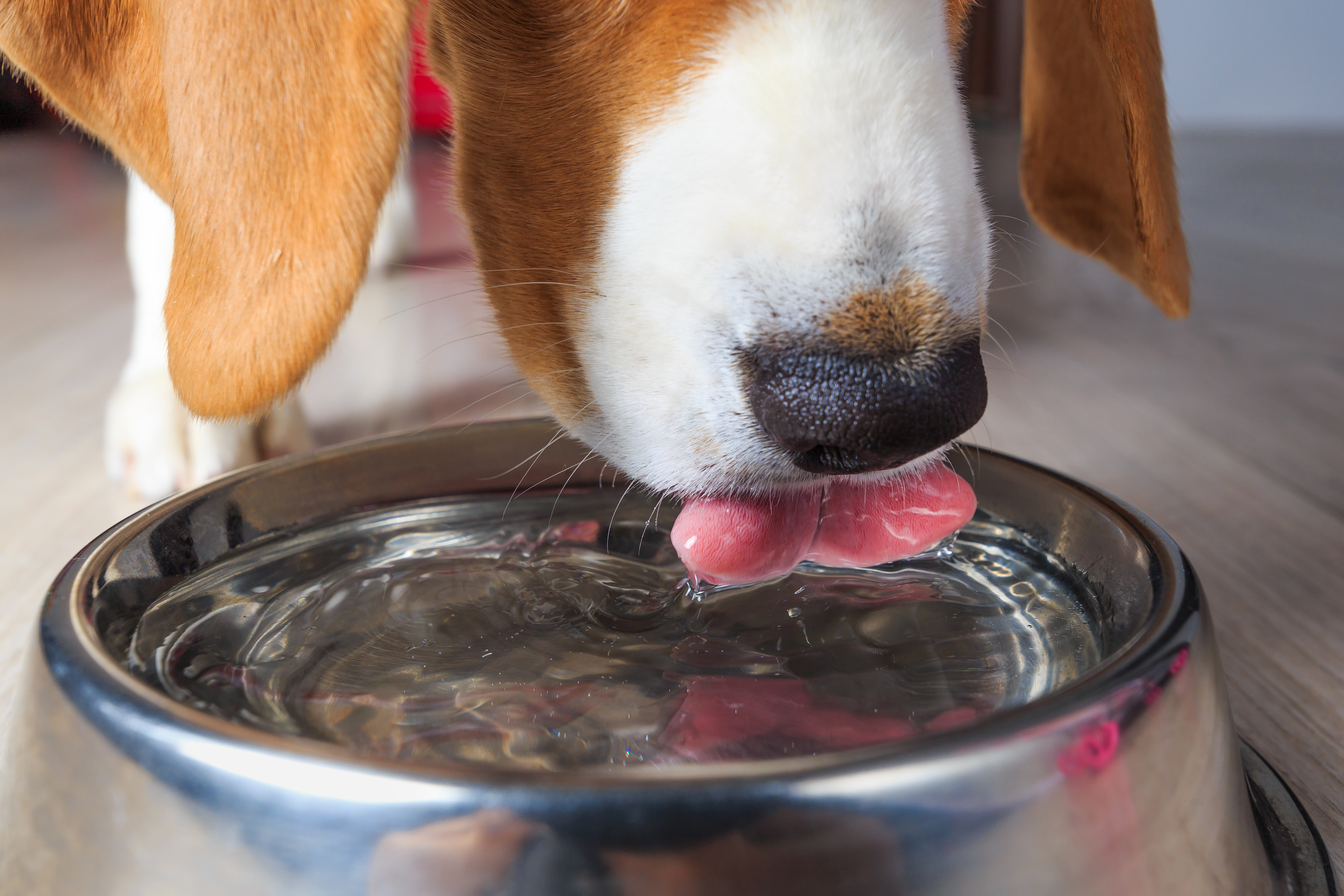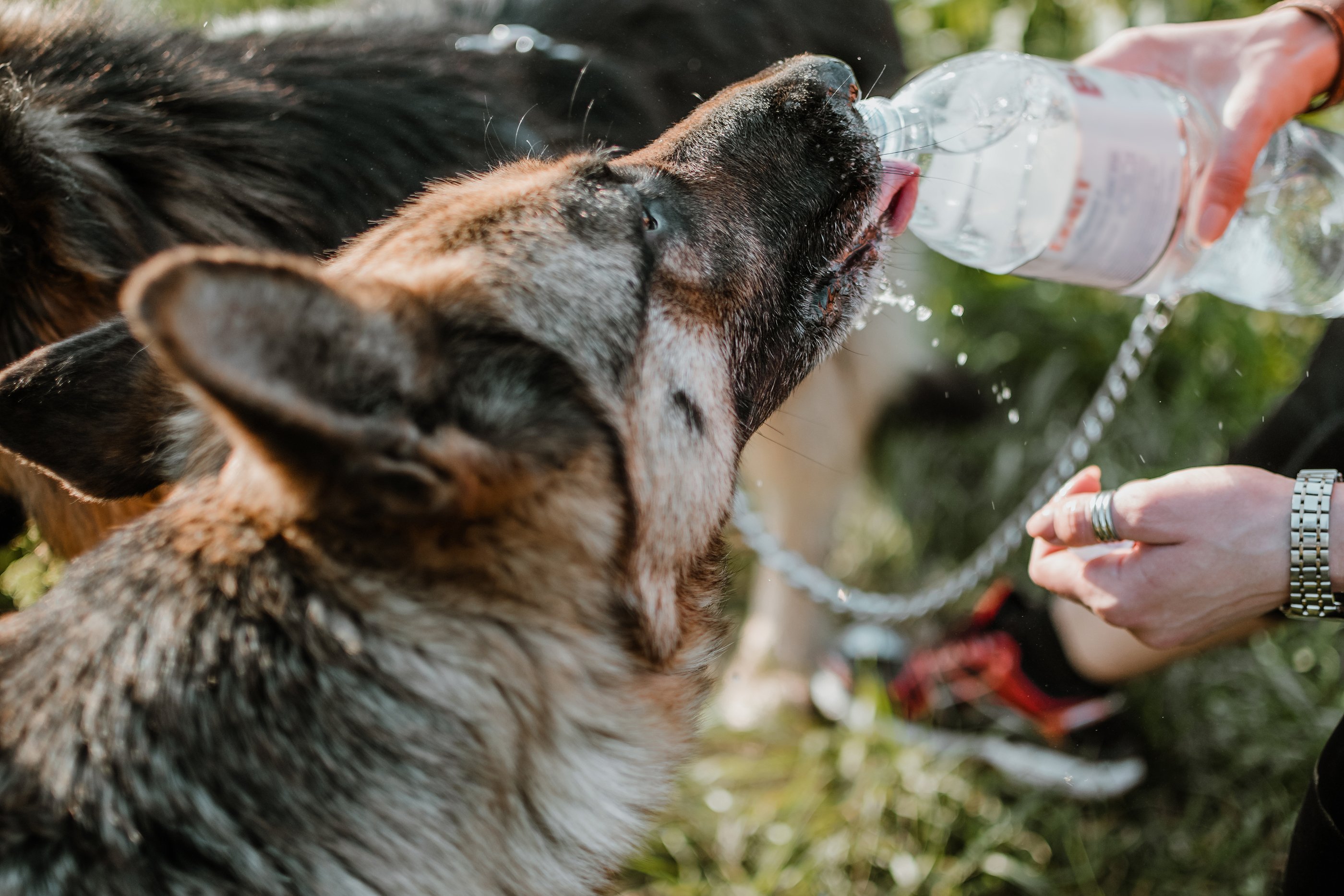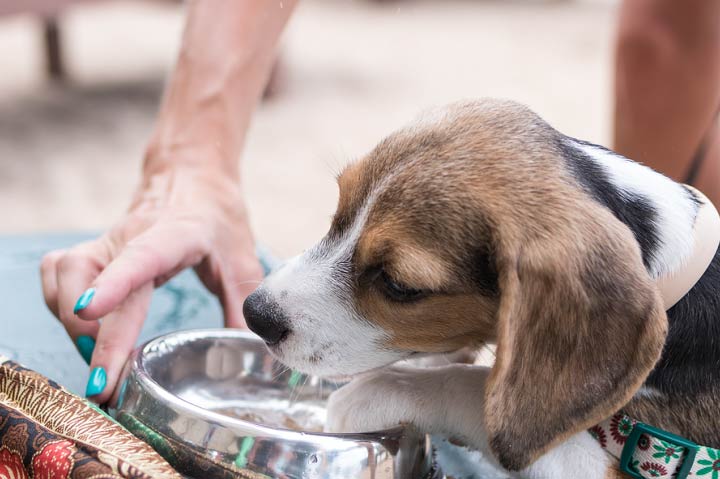
It’s my very first appointment of the morning. Otis, a 3 month-old labrador puppy, is playfully sniffing and wagging his tail around the exam room. His parent, Mrs. Somers, looks far less excited. It doesn’t look like she’s slept very well.
“Doctor”, she says, “Otis needed to go out every 3 hours and he still ended up peeing on my floor. He must have an infection or something.”
“How much water is he getting per day Mrs. Somers?” I ask.
“Well, I don’t know,” she says, “I just refill it for him when he needs more. Oh, and he also vomits up water a couple times a week. There must be something wrong.”
Oh, the challenges of being a veterinarian. Is there something really wrong with Otis? Or is his behavior just that–behavioral? If only we could actually ask Otis.
Water consumption can be a big worry for many pup parents. In this article, we’re going to go over some reasons young dogs may consume more water, including causes of dehydration that we might be concerned about. Then, we’ll go over some guidelines to know how much water your pup should have per day, and how to monitor intake. And towards the end, we’ll see what happens with Otis.
But Why is the Water Gone?
Following are a few reasons we might see a young pup suck down large volumes of water.
Behavior
Water is yummy and refreshing, and some dogs just love to drink it. Puppies are playful and curious. When really active, a puppy might go back and forth to water over and over, and sometimes it’s just because the water shimmers, sparkles, and is irresistible.
In adult dogs, a behavioral fixation in drinking water is called psychogenic polydipsia. What this truly means is that the dog has no medical need to be drinking more water, but has a psychological fixation on drinking it anyway.
The only way to arrive at a diagnosis of psychogenic polydipsia is to rule out other medical conditions, and measure out the daily water requirement and see if the pup surpasses this need. We’ll talk about both in just a couple minutes.
Medical
If we’re not talking about a behavioral cause of increased drinking, then we have to be talking about medical causes. And although we’re talking about medical causes second, these causes have to be considered and ruled out first, before we decide that “simple” behavior is to blame.
In adult dogs, the most common medical conditions that cause excessive thirst and drinking actually cause excessive urination primarily, where a pup is trying to make up for this fluid loss by drinking more. These include diabetes mellitus (similar to type I diabetes in people), Cushing’s disease (where the body is producing too much steroid hormone), and kidney disease.
Fortunately, these conditions are really rare in puppies. For example, pups can unfortunately be born with congenital kidney dysplasia, an inherited disorder where the kidneys haven’t formed properly and cannot function properly either. But conditions like these are considered the exception rather than the rule, even in pure-bred dogs.
It is important to mention that if you do notice a significant increase in water consumption and urination in your puppy or really young dog, and especially if this is accompanied by signs of decreased activity, declining appetite, digestive upset, or other sudden illness, that exposure to toxins or poisons must be considered.
Puppies are extremely curious, and so on occasion a pup may encounter a plant or household substance that can cause injury to the kidneys. Classically this includes automobile antifreeze (ethylene glycol), plants belonging to the lily family, like Easter lilies, and household pain-relievers like ibuprofen.
This is why it’s vitally important to proof your home against these sources and keep a close eye on your pup. For a list of plants and household products that can cause toxicity in pets, refer to the ASPCA Poison Control website. If you don’t see something on that list and aren’t sure, it’s always best and safest to give them a call and speak to one of their toxicologists. Your veterinarian is also a great resource for an expert opinion on some more common substances.
But barring household toxins, and medical conditions that largely affect older dogs, we may see excessive drinking in cases where other situations are causing dehydration in puppies that are otherwise active and happy. We’ll discuss some of these dehydration causes next.

Take a Break and Take a Drink: Causes of Dehydration
Exercise and Exertion
Most puppies are really active. So much so in fact, that when I forewarn puppy parents that their little pooch might be tired after a vet visit and vaccines, they sometimes breathe a sigh of relief. Sound familiar?
I try to set the expectation that for puppies who are extremely active, they may go back to the water bowl multiple times during the day to have a drink. And generally, we don’t want to deny them water (or a chance to get all of their energy out, so you can hopefully sleep at night). But it is important to take them out to use the bathroom more often too, sometimes every 30 minutes.
Active play is normal for puppies, but it can lead to dehydration, especially when it’s really warm out as we’ll talk about next. But most pups can keep up with their needs as long as water is available.
Oh, the Heat…
It’s pretty much inevitable that every year, when it really starts getting warm, we see pups at the clinic for signs related to heat stress and exhaustion. This can be especially true with newer puppy parents, who are unaware that their dog’s needs are different from their own in hot weather.
Dogs are far more sensitive to temperature change than people are. This is particularly the case with dogs that have heavy coats or who haven’t “blown” their winter coat yet, but even short-haired dogs can have a tough time in hot weather.
Unlike people, who have sweat glands all over our bodies, dogs have very few actual places they can sweat from. Sweating allows us as humans to regulate our body temperatures. When we sweat, this moistens our skin and cools us down as it evaporates. But because dogs are covered in fur, sweating would be less beneficial for them as sweat would not have much chance to evaporate.
Thus, dogs can only sweat from areas where there is very little fur, namely their noses and the pads of their feet. This is also why dogs pant so much, as it is their main mechanism of cooling themselves down.
Panting allows for evaporation of moisture from their tongues and respiratory passages, in effect cooling their bodies down in a way similar to sweating. Dogs also rely on the dilation of blood vessels, called vasodilation, in their ears to cool down as well.
It’s extremely important in hot weather to take several precautions with your puppy. Unfortunately, the same properties that make pups loyal and endearing to us can also mask signs of a problem, so don’t wait for one to arise–be proactive. In an effort to continue to be active, play, and keep up with you, your furry pal may quickly overexert himself and you won’t know until he collapses in a heap of exhausted pup.
Make sure to have fresh water available at all times with you. If you go out to jog or hike, bring a separate water bottle for your dog, along with a portable or collapsible water bowl so you can set up a rehydration station just about anywhere. And don’t rely on water sources left out at the dog park, as these common source water bowls are often sources of nasty bacteria or other parasites that can lead to illness
Always find cool places to chill and relax and take breaks. Just like kids are supposed to take a break from swimming at the pool every 45 minutes to an hour to avoid burnout and drowning risk, make sure to find a shady place to rest with your pup so she can rehydrate and burn off some of that excess heat before getting back at it.
In situations of excessive heat, it’s best to stay indoors at peak times, but if you absolutely have to be outdoors, breaks as often as every 15-20 minutes may be necessary. Otherwise, during times of peak summer, or even if there’s been a sudden excessive heat-wave during normally cooler months where your pup has little time to adjust, keep walks only in the cooler parts of the morning or evening.
And always keep humidity in mind too. If you find that being outdoors for 10 minutes has left you drenched in sweat and needing water, these conditions are not good for your pup either, and you should keep outdoor time limited.
Running into the store for a quick errand and plan to leave your pup in the car? On even just warm days, it’s best to plan on leaving the car running, or leave her at home. Even after just 10 minutes, the interior temp of a car can increase by 20 degrees, which doubles in the course of an hour. Cracking the windows just a little isn’t likely to help.
Unless it’s less than 60 degrees outside, it’s not a good idea to leave your pup in the car without the air conditioning on. For more information on these dangers, visit heatkills.org. They have university-backed data and a flow chart on the exponential increase in temperature that occurs inside a vehicle.
Digestive Upset (Vomiting and Diarrhea)
Vomiting and diarrhea can have multiple causes and are among the most common signs of illness puppy parents bring their pooches into the vet for. Fortunately most cases are mild, but in either severe cases or mild cases that go on for far too long, dehydration can occur.
While causes of GI upset can be various and your vet will be the best authority on what to do in each situation, we’ll cover some of the more common causes we see in puppies.
Viruses
The two best-known viruses that are of serious concern are parvovirus and distemper virus. Fortunately, we can vaccinate against these and the distemper/hepatitis/parvovirus/parainfluenza (DHPP or DA2PP) vaccine is considered a core vaccination series for all dogs.
Why? Distemper and parvovirus have a high rate of infection and can have a fairly high mortality rate, largely due to dehydration and secondary infections. While we don’t see as many clinical cases in practice thanks to vaccination, outbreaks still occur, especially in regions where vaccination is lax or in shelters where large volumes of unvaccinated dogs or carriers of these viruses are introduced.
But there are other, more mild viral causes of digestive upset as well, like coronavirus and rotavirus, that typically cause a more mild diarrhea that pups can get over with some supportive care.
Intestinal Parasites
Any intestinal parasite can cause diarrhea by disrupting the delicate balance of absorption in the intestinal tract. This includes roundworms and hookworms for which puppies are routinely dewormed at their earliest vet visits.
But the ones that cause the worst diarrhea include whipworms, giardia, and coccidia.
Fortunately, whipworms appear to be rare in my region of the country, but in places where they persist, it can be awful trying to get rid of them. Typically, they cause a bad watery diarrhea, and the eggs can persist in the soil environment for years.
Giardia and coccidia are not worms so much as protozoan organisms. Their cysts, which are similar to eggs, can also be found in the soil and fecal deposits of other dogs. Contaminated water sources, like those common-source water bowls at the dog park, are also potential sources.
Both giardia and coccidia can cause diarrhea, sometimes with blood seen as well. Most infections are mild but chronic recurrent infections can lead to dehydration over time. These parasites can commonly be found in puppies, especially ones that come from large crowded environments, like breeding facilities or shelters.
Treating for all three is generally straightforward, with fenbendazole most common for giardia and whipworms, and with sulfadimethoxine most common for coccidia. Re-infection through re-ingestion of the eggs and cysts can occur though, and for that reason, it is important to decontaminate the environment as much as possible, including your dog’s bottom. Wash sheets and bedding with bleach-based detergents, clean all toys and bowls with hot or boiling water, and keep your pup’s bottom clean with wipes or small “butt baths” to keep her from re-ingesting cysts that adhere to her fur.
And keep good hygiene practices for you and your family if your pup has been diagnosed with any intestinal parasite. Most are not transmissible to people directly, but roundworms can cause a secondary condition in young children or immunocompromised individuals. Giardia may be more host specific than we think, with different types affecting pets vs. people, but because we can’t easily distinguish these differences and we know giardia generally can affect both us and our pets, always take basic measures while your pet is being treated.
Many heartworm preventatives can prevent intestinal parasite infections, especially for roundworms, hookworms, whipworms, and even tapeworms, but there are no preventatives for giardia and coccidia, other than avoiding locations that may be environmental sources.
It Seemed So Tasty at the Time…
Pups love to put lots of things in their mouths. Why? Because their sense of smell is many times that of our own. Dogs have somewhere between 200 to 300 million olfactory receptors, whereas we humans have a pittance of only 5 million.
This means that dogs can detect multiple odors from a single object, making something as gross to us as another animal’s stool deposits absolutely fascinating to a pooch.
Unfortunately, this does sometimes mean a dog will give a taste to what seems to smell so amazing. This includes not just fecal leavings from other animals, but also decaying animals like dead birds or mice, rancid food that was thrown out of a car window or dropped off the garbage truck, and of course your own trash at home.
It can’t really be overstated how much bacterial contamination exists on and within these “leftovers”, and it’s no wonder why many pups can get sick from eating such things. Some bacteria, like E. coli, contain toxins that can cause damage to the intestinal lining, worsening signs of diarrhea and vomiting.
The only thing you can really do here is to be vigilant and be aware of what is in the immediate environment that your pup might be able to get ahold of.

How to Know if Your Puppy is Dehydrated
Whatever the cause of dehydration, there are some signs that are consistent that you can look for to be able to tell.
Mucous Membranes
The mucous membranes are areas near bodily openings that consistently stay moist and have a high degree of blood flow, making them look pink. The easiest mucous membranes to monitor are the inside of the lips and the gums, and changes with them can help determine if a dog is dehydrated.
Mucous membranes should always appear pink and moist to the touch. If they feel sticky or tacky, or even dry, then the presence of dehydration is possible.
Capillary Refill Time
The capillary refill time, or CRT, is a common assessment for shock and dehydration. If you push firmly on a mucous membrane, like the inside of the lips or gums, it should briefly blanch from the pressure. But as soon as you release it, blood flow should return immediately, making the area pink again. This process should take less than 2 seconds. If it lasts any longer than that for the tissue to return to its pink color, this means the pet has poor circulation. Dehydration is the most common cause of a delayed CRT. If a delayed CRT is present combined with sticky or dry gums or lips, dehydration is almost certainly present.
Skin Tent
This is another simple way to assess hydration status. Dog’s have skin that is much more elastic than our own. If you firmly but gently grab the skin over the shoulder blades, you should be able to pull it up into a tent shape. But if you let it go, it should go back almost immediately to its normal position.
If the skin returns to normal immediately, we can safely say that a pet is at least less than 5% dehydrated. If the skin takes a little longer, maybe 1-2 seconds, we can roughly estimate about 5-8% dehydration. If it takes any longer, or doesn’t return at all, 8-10% or more dehydration is present. Although it may seem like a small amount, dehydration over 10% is extremely concerning, requiring immediate veterinary care.
For best results in assessing dehydration, make sure to take more than just one sign into account. A dog that is panting a lot and has mildly tacky gums but normal skin tent and is otherwise happy and playful, may need some water, but isn’t in any dire straits. But a dog with a prolonged skin tent, and tacky gums who is acting very slow and weak, is likely dehydrated.
It’s important to note as well that dogs who are overweight may have little to no skin tent normally, even if dehydration is present. Conversely, dogs who have lost a lot of weight may have a prolonged skin tent even if dehydration is not present. In these cases, your veterinarian will be the best judge of whether illness is truly present or not.
How Dehydration is Treated
Because dehydration can have so many causes, we won’t go into details for all situations. But generally, assessing dehydration at your vet will consist of an examination to assess the parameters we just discussed.
Bloodwork is also often performed depending on the level of concern, as we can see some abnormalities secondary to dehydration to confirm the need for certain treatment measures, and look for any underlying concerns.
Fluid therapy is the hallmark of addressing dehydration, but the amount and manner in which it is administered may differ depending on the degree of dehydration and the underlying cause. For minor cases, it is very common for veterinary staff to administer some fluids, like lactated ringers or normal saline, under the skin of dogs.
Remember that skin tent test? The elasticity of the skin also makes for a convenient way to provide a bolus of fluids into the space beneath the skin, which is called subcutaneous fluids. This is nice, because we can administer a modest volume of fluids to a mildly dehydrated pet in a very short time frame.
But sometimes, in cases of more severe dehydration, subcutaneous fluids aren’t sufficient and we have to administer fluids directly into a vein, which is called intravenous fluids. This is what is similar to a human “getting an IV”. This method is more costly, stressful for the pet, and time consuming, and so is usually reserved for more serious cases.
If your vet recommends fluids for your pup, it’s best to take his or her advice. One argument I often hear against doing fluids and saving some cost is that “she’s drinking plenty of water”. But water alone is not able to replenish all of the electrolyte loss that occurs with dehydration, especially when vomiting and diarrhea are involved.
And in some cases, a pup will never be able to keep up with those fluid losses by drinking water alone. What about oral rehydration with Gatorade or Pedialyte? Gatorade is not a good idea, as it is composed mostly of sugar, which can actually make some diarrhea worse in pets.
Pedialyte is okay, as long as it’s not being given exclusively. It is so electrolyte rich that it can actually cause imbalances in pets if given on its own in large amounts. Applying a capful with a quart of water may help provide some modest electrolyte replacement, but may still not be sufficient in more serious cases.
In addition to addressing dehydration, your veterinarian will also look to address whatever the underlying cause is, like vomiting, diarrhea, heat exhaustion, etc.

How much water should a puppy drink?
There actually is a standard daily amount of water that we expect any healthy dog to consume. Generally, a pup should consume somewhere between 60 to 90 milliliters per kilogram per day. To translate this into practical amounts, remember that a kilogram is 2.2 pounds, and a cup is about 240 milliliters.
So a small 10lb puppy would need between 1 and 2 cups per day. A 25lb dog on the other hand, would need between 3 to 4 cups per day. Getting closer to 50lb? You’re looking at 6-9 cups.
These are guidelines, so I do make sure puppy parents are aware that water consumption can vary depending on activity level and not to get too paranoid about restricting water when a pup is playing and needs to rehydrate.
If a pup parent tells me that their 25lb puppy is drinking 4-5 cups per day on days when he goes to the dog park, this concerns me far less than if that same puppy is sitting at home in his crate and draining the same amount as a 50lb dog..
So, if your pup is clearly consuming more than this amount and no extra activity seems to explain it, a medical problem could be present that should be assessed by your pup’s doc.
Tips on How to Monitor Water Intake
So, knowing the range of how much a pup should have per day, the best way to monitor intake and determine if your puppy is really consuming too much water, is to measure out the daily requirement into a gallon jug and set it aside. When the water bowl is empty, only refill it from that pre-allotted amount of water.
If you’re having issues with potty training and want to know if your pup is drinking too much, keep a log book that details how much he’s drinking during the day, as well as how often you let him out for bathroom breaks. When you discuss these concerns with your veterinarian, having this record can help determine if a discrepancy or problem truly exists.
If you find that you do pretty well during the day, but your puppy is begging to be let out in the middle of the night, consider limiting water at the close of day. Puppies should be able to hold it overnight for at least 8 hours by around 12-16 weeks of age. If you still find yourself getting up every 4 hours and your pup has water left overnight in her crate, you may want to remove it before bed.
It is really important to take proper steps to assess water intake before making adjustments and to check with your vet before taking any drastic steps to reduce or eliminate water. Don’t just assume that potty accidents in the house are related to too much water, as there are many other behavioral points that may need to be worked on. Restricting too much water when your pup needs it can also lead to dehydration and illness.
Concerned your pup isn’t drinking enough? Some of the same monitoring rules apply. Measure out the daily amount of water he needs and see if his consumption amount fits within that range. Also, check on those signs of dehydration we talked about. If none of those signs are present and your puppy looks happy and otherwise healthy, and especially if he’s drinking at least the low end of the daily water consumption amount you calculate, there’s really no reason to be overly concerned.
Back to Otis
So now knowing what we’ve learned about dehydration and water consumption, let’s revisit Otis and Mrs. Somers, and see how things panned out.
After asking Mrs. Somers a few more questions, I found that she generally refills Otis’ water bowl whenever it appears empty. He is pretty well crate-trained, but he does have water available all night long. Mrs. Somers also tends to take Otis out only at times most convenient for her, which are not at regular intervals.
Otis had a pretty normal exam, with no signs of clinical dehydration. I did examine a sample of his urine, which appeared completely normal and clear of any signs of infection, blood, high protein levels, crystals, or other abnormalities.
A few things were then suggested to Mrs. Somers to help with this issue, which was determined to be behavioral, not medical. First, I advised measuring out the daily amount of water Otis needs and using that supply exclusively to refill his bowl from. Once we did this, we found that he wasn’t really drinking more than his daily requirement.
I also had Mrs. Somers remove Otis’ water from his crate at night before bed, making sure he met his need after his evening walk and play time. During the day, she portioned his water out in smaller allotments as needed.
To help further address the potty accidents, Mrs. Somers began to keep a log of Otis’ potty times as well as any accidents, to get a clear picture of what intervals were needed and at what times of the day he needed to go out.
With these guidelines and some in-home leash training to help catch the accidents he was having, Otis’s inappropriate urinary behaviors resolved after just a couple weeks of consistent work. Without a large amount of water to gulp down, Otis stopped vomiting up water as well. And Mrs. Somers was able to sleep much better.
And just a couple weeks of good, consistent training and dedication can be all it takes for a lifetime of health and good behaviors. Otis and Mrs. Somers may be fictional names, but they represent a real pet and parent, and a real case that represents the ones veterinarians see quite commonly. Otis might just have easily had a urinary tract infection and required antibiotics to return to normal. But because it can be so hard to tell at home if there is a medical problem, this highlights the importance of taking your pup to your vet when you have any health concerns.
About Us
We've taken the guesswork out of caring for your pets. Our formulations are created by experienced veterinarians to address specific solutions for a variety of pet issues.
All of our products are:
As seen on:











